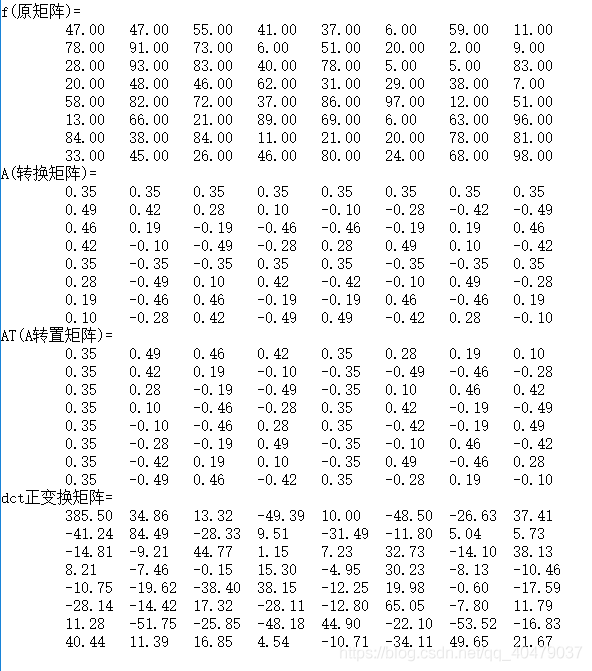图像DCT原理C语言实现
图像DCT算法
@(Learning)[Auspice Vinson]
介绍
DCT 离散余弦变换,常用图像变换算法
- 分割:将图像分割成88或1616的小块
- DCT变换:对每块进行DCT变换
- 舍弃高频系数(AC系数),保留低频系数(DC系数)
- 高频系数一般保存的是图像的边界、纹理信息
- 低频系数保存的图像中平坦区域信息
- 图像的低频和高频
- 高频区域指空域图像中突变程度大的区域
图像
二维DCT变换就是将二维图像从空间域转换到频域
- 计算图像是由哪些二维余弦波构成
正变换
F = A f A T F = AfA^T F=AfAT
A ( i , j ) = c ( i ) c o s [ ( j + 0.5 ) π N i ] A(i,j) = c(i) cos[\frac{(j+0.5)\pi} {N}i] A(i,j)=c(i)cos[N(j+0.5)πi]
c ( i ) = { 1 N , i = 0 2 N , i ≠ 0 c(i)=\left\{\begin{array}{rcl}\sqrt{\frac{1}{N}}, & & {i =0}\\\sqrt{\frac{2}{N}}, & & {i\neq{0}}\\\end{array} \right. c(i)=⎩⎨⎧N1,N2,i=0i=0
- F 位变换得到的系数
- f为图像像素值
- A为转换矩阵
- i 为二维波的水平方向频率
- j为二维波的垂直方向频率
- 取值范围都是 0-(N-1)
- N为图像块大小
变换步骤
- 求出转换矩阵A
- 利用转换矩阵A,转换到频域
- 由图像f的到系数矩阵F
数字模拟
# include反变换
F = A f A T F=AfA^T F=AfAT
f = A − 1 F ( A T ) − 1 f = A^{-1} F (A^T)^{-1} f=A−1F(AT)−1
A是正交矩阵,所以有 A T = A − 1 AT=A−1 AT=A−1,所以求得:
f = A T F A f = A^TFA f=ATFA
# includeDCT大作业
流程图
代码
# includeDCT系数特点
- DCT后的64个DCT频率系数与DCT前64个像素块对应
- DC系数为出发点向下,向右的其他DCT系数,离DC分量越原,频率越高,幅度值越小
- 单独一个图像的全部DCT系数块的频谱几乎集中在左上角系数块中
原因
- DCT是没有压缩的无损变换过程
- DCT的低频系数代表了图像的背景、轮廓,是保证图像传输业务质量(QoS)的重要信息
- DCT高频系数是反映图像的边缘、细节的较次要的信息



